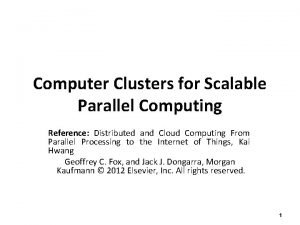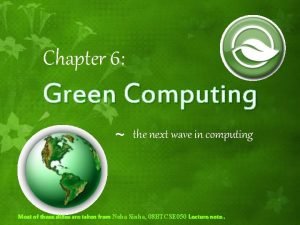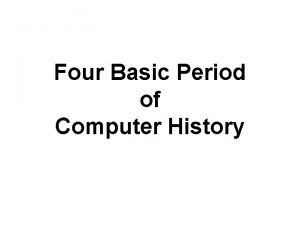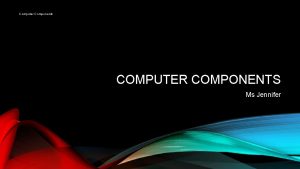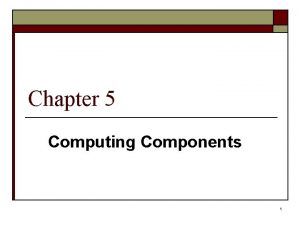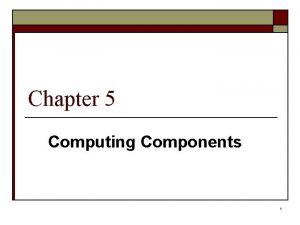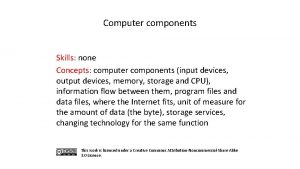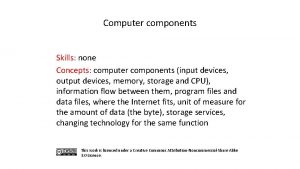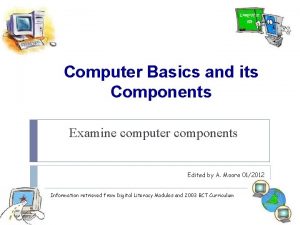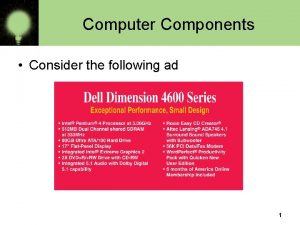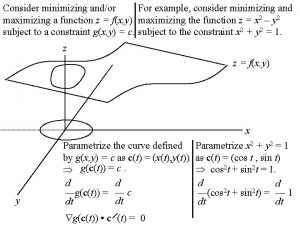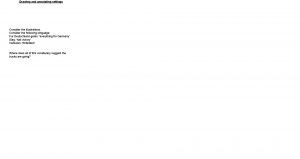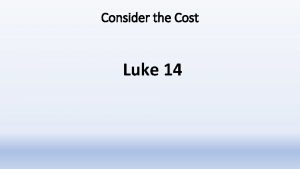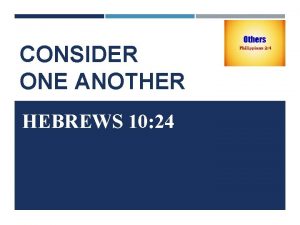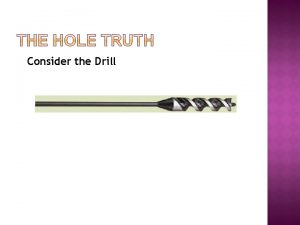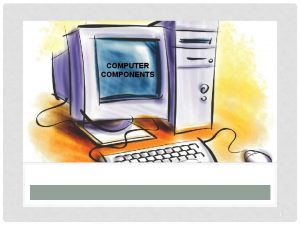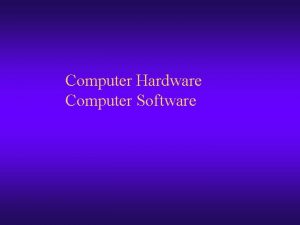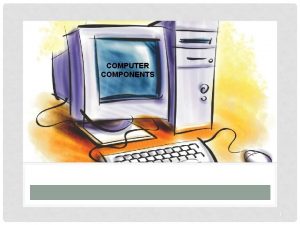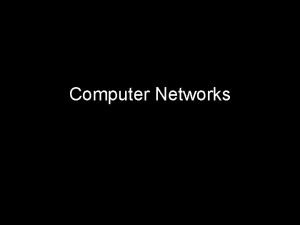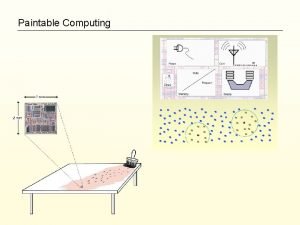Chapter 5 Computing Components Computer Components Consider the




























- Slides: 28

Chapter 5 Computing Components

Computer Components Consider the following ad: 2

Computer Components The terms are explained in the text so let’s focus on the units associated with the numbers: o 3. 06 GHz o 512 MB o 333 MHz o 80 GB o 56 K 3

Computer Memory Remember that 1 byte contains 8 bits. K MB GB TB = = 1024 K = 1024 MB = 1024 GB 1024 1048576 1073741824 1. 13 E+15 bytes 4

Sizes in Perspective Admiral Grace Murray Hopper n A coil of wire nearly 1, 000 feet long represents the distance traveled by an electron in the space of a microsecond. n A 1 foot (30+ cm) piece of wire represents the distance traveled in the space of a nanosecond. n A bag containing grains of pepper represents the distance traveled in the space of a picosecond. 5

Sizes in Perspective 6

Stored-Program Concept 7

Arithmetic/Logic Unit o o o Performs basic arithmetic operations such as adding. Performs logical operations such as AND, OR, and NOT. Most modern ALUs have a small number of special storage units called registers. 8

Control Unit The organizing force in the computer. There are two registers in the control unit: n n The instruction register (IR) contains the instruction that is being executed. The program counter (PC) contains the address of the next instruction to be executed. ALU and control unit comprise the Central Processing Unit, or CPU. 9

Memory is a collection of cells, each with a unique physical address. 5 -8

Flow of Information The parts are connected to one another by a collection of wires called a bus. 11

The Fetch-Execute Cycle o o Fetch the next instruction Decode the instruction Get data if needed Execute the instruction 12

The Fetch-Execute Cycle 13

RAM and ROM RAM stands for Random Access Memory. n Inherent in the idea of being able to access each location is the ability to change the contents of each location. ROM stands for Read Only Memory. n The contents in locations in ROM cannot be changed. RAM is volatile, ROM is not. n This means that RAM does not retain its bit configuration when the power is turned off, but ROM does. 14

Secondary Storage Devices Because most of main memory is volatile and limited, it is essential that there be other types of storage devices where programs and data can be stored when they are no longer being processed. Secondary storage devices can be installed within the computer box at the factory or added later as needed. 15

Magnetic Tape The first truly mass auxiliary storage device was the magnetic tape drive.

Magnetic Disks A read/write head travels across a spinning magnetic disk, retrieving or recording data.

Compact Disks o o o A CD drive uses a laser to read information stored optically on a plastic disk. CD-ROM is Read-Only Memory. CD-RW is Read/Write. CD-DA is Digital Audio. CD-WORM is Write Once, Read Many. DVD stands for Digital Versatile Disk. 18

Input/Output Units Input Unit - A device through which data and programs from the outside world are entered into the computer. n Keyboard, mouse, and scanning devices Output unit - A device through which results stored in the computer memory are made available to the outside world. n Printers and video display terminals 19

Touch Screens Touch screen - A computer monitor that can respond to the user touching the screen with a stylus or finger. There are three types: n n n Resistive Capacitive Infrared o Surface acoustic wave (SAW) 20

Touch Screens Resistive touch screen - A screen made up of two layers of electrically conductive material. n n n One layer has vertical lines, the other has horizontal lines. When the top layer is pressed, it comes in contact with the second layer which allows electrical current to flow. The specific vertical and horizontal lines that make contact indicate the location on the screen that was touched. 21

Touch Screens Capacitive touch screen - A screen made up of a laminate applied over a glass screen. n The laminate conducts electricity in all directions, and a very small current is applied equally on the four corners. n When the screen is touched, current flows to the finger or stylus. n The location of the touch on the screen is determined by comparing how strong the flow of electricity is from each corner. 22

Touch Screens Infrared touch screen - A screen with crisscrossing horizontal and vertical beams of infrared light. n Sensors on opposite sides of the screen detect the beams. n When the user breaks the beams by touching the screen, the location of the break can be determined. 23

Touch Screens Surface acoustic wave (SAW) - A screen with crisscrossing high frequency sound waves across the horizontal and vertical axes. n When a finger touches the surface, the corresponding sensors detect the interruption and determine the location of the touch. 24

Non-von Neuman Architectures o o o The linear machine cycle is still dominant. Since 1990, the concept of parallel processing has attracted significant research. 3 basic approaches: n n n Synchronous processing Pipelining Shared-memory configuration 25

Synchronous Processing One approach to parallelism is to have multiple processors run the same program on multiple data sets. 26

Pipelining … arranges processors in tandem, where each processor contributes one part to an overall computation. 27

Independent Processing with Shared Memory 28
 Conventional computing and intelligent computing
Conventional computing and intelligent computing Computer clusters for scalable parallel computing
Computer clusters for scalable parallel computing History of green computing
History of green computing Electro mechanical age
Electro mechanical age Hình ảnh bộ gõ cơ thể búng tay
Hình ảnh bộ gõ cơ thể búng tay Ng-html
Ng-html Bổ thể
Bổ thể Tỉ lệ cơ thể trẻ em
Tỉ lệ cơ thể trẻ em Chó sói
Chó sói Chụp tư thế worms-breton
Chụp tư thế worms-breton Chúa sống lại
Chúa sống lại Các môn thể thao bắt đầu bằng tiếng đua
Các môn thể thao bắt đầu bằng tiếng đua Thế nào là hệ số cao nhất
Thế nào là hệ số cao nhất Các châu lục và đại dương trên thế giới
Các châu lục và đại dương trên thế giới Công thức tính thế năng
Công thức tính thế năng Trời xanh đây là của chúng ta thể thơ
Trời xanh đây là của chúng ta thể thơ Mật thư anh em như thể tay chân
Mật thư anh em như thể tay chân 101012 bằng
101012 bằng độ dài liên kết
độ dài liên kết Các châu lục và đại dương trên thế giới
Các châu lục và đại dương trên thế giới Thơ thất ngôn tứ tuyệt đường luật
Thơ thất ngôn tứ tuyệt đường luật Quá trình desamine hóa có thể tạo ra
Quá trình desamine hóa có thể tạo ra Một số thể thơ truyền thống
Một số thể thơ truyền thống Cái miệng xinh xinh thế chỉ nói điều hay thôi
Cái miệng xinh xinh thế chỉ nói điều hay thôi Vẽ hình chiếu vuông góc của vật thể sau
Vẽ hình chiếu vuông góc của vật thể sau Biện pháp chống mỏi cơ
Biện pháp chống mỏi cơ đặc điểm cơ thể của người tối cổ
đặc điểm cơ thể của người tối cổ Thứ tự các dấu thăng giáng ở hóa biểu
Thứ tự các dấu thăng giáng ở hóa biểu Vẽ hình chiếu đứng bằng cạnh của vật thể
Vẽ hình chiếu đứng bằng cạnh của vật thể

